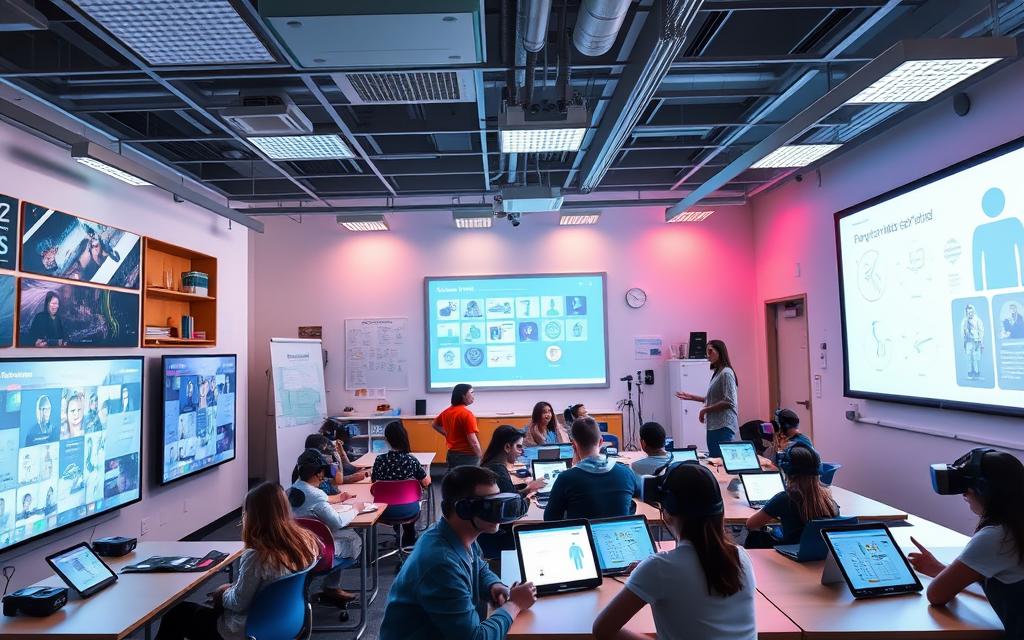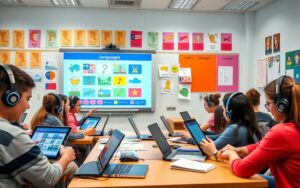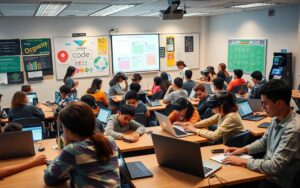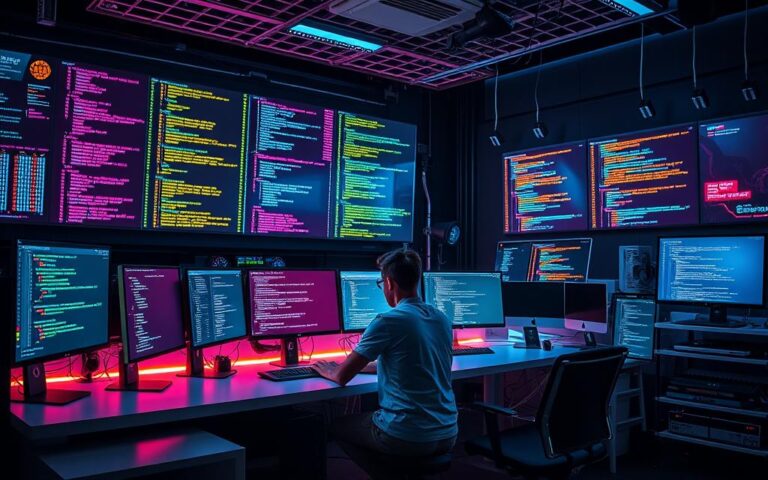Definition and Role of Educational Technology
Educational technology involves studying and using tech tools in learning and teaching. It aims to make education better. At first, it started with simple tools like the abacus. Now, it includes advanced tech such as virtual reality and AI. Educational technology today does more than offer tools. It works to make how we teach and learn even better.
Those with a Master’s in Educational Technology have found exciting jobs. They work as Technology Teachers and Digital Curriculum Developers. This shows the variety of paths in this field. Education technology is constantly changing. Trends like online learning, makerspaces, and soon, robotics, will change how we learn and teach.
Understanding Educational Technology
Understanding educational technology is about knowing its definition and history. As tools for improving education grow quickly, it’s important to understand their impact. These technologies play a big role in today’s learning environments.
The Definition of Educational Technology
Educational technology means using tech tools and new ways to make learning better. It covers software, hardware, and methods that help students get involved and teachers improve. It also supports learning that suits each student.
For example, programs that adapt to each student’s pace and online platforms like Google Classroom help. They let students learn in their way. This boosts critical thinking and teamwork, which are key skills for the future.
Historical Context
The history of educational technology shows major changes. It began with simple teaching aids and moved to complex digital platforms. According to the National Center for Education Statistics, technology makes students more independent. It also encourages them to work together.
In the 2022-2023 school year, U.S. K-12 schools used about 2,591 educational tech tools. This shows a big increase in using technology in education. The goal is to make learning more engaging and effective.
What Do You Mean by Education Technology
Education technology covers a wide array of tools, apps, and strategies. They aim to enhance learning both in and outside the classroom. The meaning of education technology touches on various hardware and software tools. These tools offer digital platforms for educational purposes. They help educators tailor learning experiences, improving communication between students and teachers.
The EdTech industry is growing fast, worth nearly 123.4 billion in 2022. It’s expected to rise by 13% each year until 2030. This growth shows how vital educational technology is in today’s learning spaces. Technologies like virtual reality and artificial intelligence have transformed interactive learning. They make educational technology crucial for modern teaching methods.
Different approaches help explain what is education technology. Asynchronous learning uses pre-recorded lectures, letting students learn at their pace. Blended learning mixes face-to-face lectures with online parts. This makes education more comprehensive. Tools like cloud-based software and interactive platforms show how ICT in education supports learning. They help students and teachers in various environments.
Technology’s link to education opens up a broader vision of what education technology is. Yet, some teachers use old content, limiting students’ access to new practices. However, curricula focused on projects and interactive tech aim to integrate technology into lessons effectively.
Learning about technology through coding and programming provides crucial skills for the future. While there are hurdles in linking technology projects to the real world, more schools favor blended learning. Frameworks that span multiple subjects, like the K-12 Comp-Sci Framework, promote deeper learning. They place educational technology as a key element in today’s teaching.
| Area of Focus | Details |
|---|---|
| Asynchronous Learning | Pre-recorded lessons for self-paced study |
| Blended Learning | Combination of online and live learning experiences |
| Education ICT | Use of software and technologies for educational purposes |
| Technology Education | Includes coding, programming, and computer science |
| Growth Statistics | EdTech projected to grow by 13% yearly until 2030 |
| Teacher Engagement | Focus on incorporating technology in curriculum development |
The Importance of Educational Technology in Modern Learning
Educational technology is key in changing today’s education scene. It makes learning more engaging for students using new methods. Technology helps make the learning environment active and interesting. Investing in technology brings big rewards for both students and teachers.
Enhancing Student Engagement
Technology brings fresh, interactive ways to learn in classrooms. 72% of students say they’re more involved in learning with technology. Digital tools like games, virtual reality, and online platforms make learning fun and accessible. They help students from different backgrounds to learn better.
Many middle school students say these tools help them get better grades. 59% link their success to digital learning. Where technology is part of learning, students’ performance goes up by 23%. This shows how important technology is for improving learning results.
Supporting Teacher Development
Teachers also benefit from educational technology. 92% of them see its positive effect on teaching. Technology offers ways for teachers to learn and try new teaching methods. This helps them support different ways students learn.
Places like American University’s School of Education have online courses for teachers. These help them use technology well in their teaching. This training improves the education quality by supporting teachers’ growth.
Examples of Educational Technology Tools
In the world of education, many technology tools have made learning better and more interactive. These tools help students in different settings and meet various educational goals.
Here are the main types of these tools:
| Type | Examples |
|---|---|
| Social Learning | Flip, Google Classroom, Schoology, Kahoot, ClassDojo, OpenStudy, Padlet |
| Lesson Planning | Teachers Pay Teachers, HyperDocs, Prezi, Timetoast, Google Docs, Nearpod, FluentBooking |
| WordPress LMS Plugins | Masteriyo, LearnDash, LifterLMS, TutorLMS, LearnPress |
| eLearning Platforms | Khan Academy, Knewton, Code.org, BYJU’s online, CommonLit, Coursera, CarrotSticks, StudySync |
These tools are great for school kids. They help with working together, thinking deeply, and understanding technology better. Tools like Google Classroom make talking and sharing work easy. They also let teachers give quick feedback.
Using virtual reality, like Google Expeditions, kids can learn in a whole new way. It makes it fun to remember what they learn about different topics. Platforms like Khan Academy change to fit each student, making learning more interesting.
3D printing helps students learn tough ideas by doing. Putting these edtech examples into education daily makes learning better. It gets students ready for a fast-changing future.
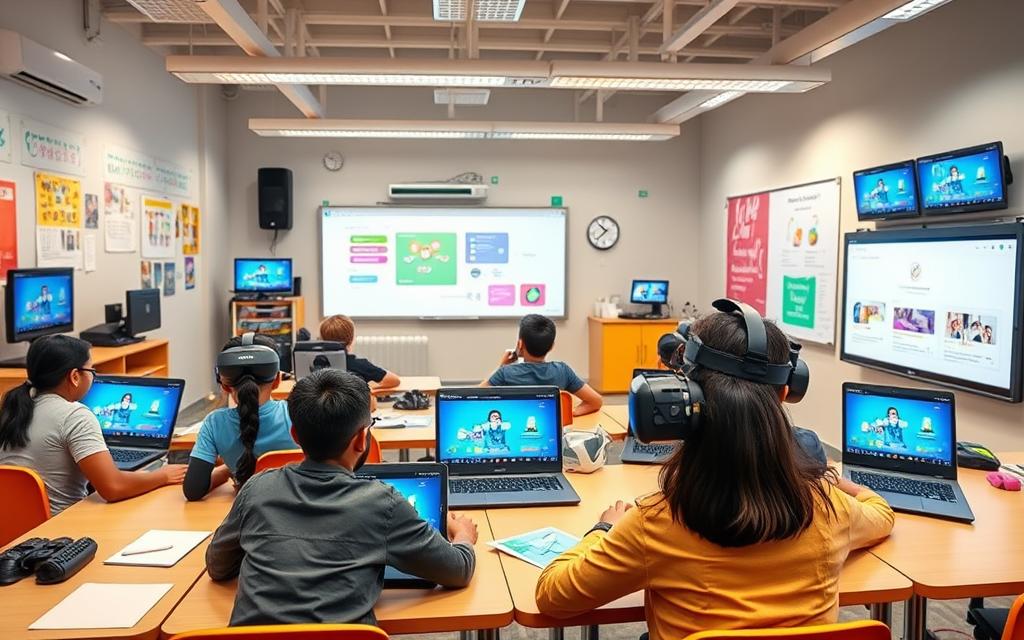
Challenges and Considerations in Educational Technology
Integrating tech into classrooms has its challenges in educational technology. Stakeholders bump into various obstacles, from lack of infrastructure to ethical issues. Understanding these issues deeply and committing to find solutions is key.
Overcoming Implementation Barriers
Implementation barriers are common as organisations try to use tech in teaching. They face issues such as:
- Limited teacher training, hindering effective tech use.
- A resistance from educators not familiar with new tools.
- Budget constraints limiting access to good resources and infrastructure.
In 2009, data showed 97% of public school teachers had a computer in their classroom. This was a big jump from 1999. Yet, the student to computer ratio was 5.3 to one. This shows the need for more resources. As schools move towards personalised learning, planning and ongoing training are key. A solid plan should tackle teacher training and resource needs. This ensures tech enriches learning well.
Addressing Ethical Considerations
Using tech in education brings up ethical considerations. Schools gather a lot of data, sparking worries about data privacy and fair access. Surveillance to boost participation might invade student privacy. This leads to concerns about data security and the ethics of watching students.
Also, making sure every student has fair tech access is tricky. This is crucial in special education. Working to make technology an aid, not a barrier, helps tackle these ethical issues.
To deal with challenges in educational technology, we must take active steps. Talking about ethical use and finding good ways to implement tech helps teachers and students. It improves education for everyone.
Conclusion
Educational technology is changing how we learn. It includes new tools, like software and hardware, that make learning better. With technology, learning can be more fun and fit what each student needs. But, using it the right way is very important to make sure it works well.
The future of this technology depends on teachers, technologists, and rule makers working together. They should focus on what students need to learn well. Teachers need to keep learning new ways to teach with technology. This helps them meet all their students’ different needs.
Adding technology to education is a journey that’s still going on. Tools like podcasts, smart classrooms, and online platforms can make learning more engaging and help students remember more. Everyone involved needs to keep working on this. Their hard work will help students do better in the future.
FAQ
What is educational technology?
Educational technology is the study of how tech can improve teaching and learning. It covers everything from designing to evaluating learning environments and materials.
How has the role of educational technology evolved over time?
From simple tools like abacuses to high-tech virtual reality, educational technology has grown. It now includes artificial intelligence and gamification to make learning collaborative and engaging.
What are some common tools used in educational technology?
There are many tools in educational technology. They include learning management systems, interactive panels, and virtual reality. Online quizzes and AI also offer hands-on learning experiences.
What are the benefits of educational technology in modern learning?
It makes learning interactive and tailored to each student. Technology also helps teachers learn new teaching strategies and use technology better in their lessons.
What challenges are faced when integrating educational technology?
The challenges include not enough training for teachers and not knowing how to use new tech. Problems also come from not enough infrastructure and concerns over data privacy and fair tech access.
How can educators overcome barriers to implementing educational technology?
Teachers can beat these barriers through ongoing professional development and planning. Working together also helps them learn how to use technology to improve learning.
Why is ethical consideration important in educational technology?
It’s important to make sure the tech we use protects data privacy and follows the rules. It should also make sure all students can access technology fairly.
What is the future of educational technology?
The future will see more teamwork between teachers, tech experts, and policymakers. This collaboration will drive innovation while focusing on learning that puts students first and uses advanced tech.
